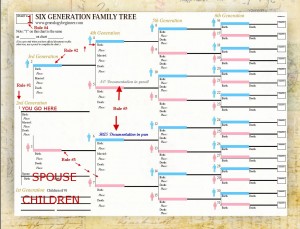Search results
Donating Genealogical Records
June 28, 2012 by ramona
Filed under Articles, Latest News, Preserving Your Family Tree
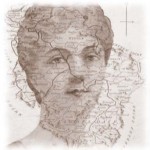 Have no doubt that your family tree research has value beyond the current generations of your own family.
Have no doubt that your family tree research has value beyond the current generations of your own family.
Donating your family history to a local historical or genealogy group is an excellent way to make certain all of your hard work is put to good use. Local Historical Societies and Genealogy groups have a stake in preserving your records for future generations.
How to Donate Your Family Tree
If you are considering donating your family tree research the best place to start is by contacting your local library. Your local library can help you identify the archives that are best geographically suited to receive your family’s story.
Generally, community groups are interested in local reference records. However, they may have ties to other groups with broader interests such as provincial or state archives.
When donating a rather widespread family tree it may be worth considering breaking it into smaller portions focusing on specific locations.
While it is normal in a large family tree to have a significant geographical spread with ancestors coming from all corners of the globe, a local group may have limited space. Therefore, it is reasonable that they may not want to house large documents unless they are completely location specific.
What to Include with Your Donation
Along with your family tree templates or pedigree charts, you should include either originals or copies of:
- Primary and secondary source documents
- Old photos
- Vital Records
- Newspaper clippings
- Maps
Donating your family tree data is one of the best ways of sharing your genealogy and contributing to the preservation of history in your community. Not only does it help preserve your research for future generations it may be key to helping another family history researcher to break down a brick wall.
However, before you donate be sure not to part with any original items you or other members of your family may want to keep. Lastly, make certain that all of your research conforms to The Big Five Genealogy Standards and Guidelines.
To learn more about genealogical standards sign up today for Genealogy Beginner’s 30-day free trial and receive Eight, Step-by-Step Weekly Lessons You Can Do At Your Own Pace. Starting with Lesson 1: Genealogy Standards And Guidelines.
1940s Census Sees Overwhelming Support from Volunteer Indexers
April 19, 2012 by ramona
Filed under Articles, Latest News
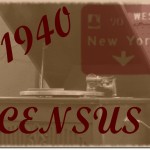
The genealogy community is alive with the spirit of giving and sharing as can be seen by the overwhelming efforts of volunteer indexers. As of April 20, 2012, the 1940’s Census Project has over 75,820 indexers.
Since the release of the census on April 2nd:
- So far, 14.2% has been completely indexed
- Colorado and Kansas have been completely indexed and are being processed in preparation for posting
- Delaware is posted online
- Nine states are 80% or more indexed and will soon be complete
Thanks to the extraordinary efforts of volunteer indexers, Family Tree buffs will soon be filling out their family Tree template with the census information of their recent ancestors who were living in the United States in 1940.
Family search promises to keep all of us updated every few days with their progress, check with them regularly to find the release date for your state of interest. For genealogists eagerly awaiting records for specific states here is a list of states that have been posted to date:

Genealogy Beginner thanks and congratulates all of the volunteer indexers for their heroic efforts. This is quite an accomplishment for the first week of indexing.
Titanic Records Released for 100 Year Anniversary
April 10, 2012 by ramona
Filed under Articles, Latest News
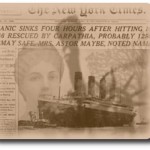 April 15th 1912 is the date that marks the sinking of the RMS Titanic. In remembrance of this, the 100th anniversary marking the loss of 1500 souls, a collection of over 200,000 records have been published.
April 15th 1912 is the date that marks the sinking of the RMS Titanic. In remembrance of this, the 100th anniversary marking the loss of 1500 souls, a collection of over 200,000 records have been published.
Included in the collection are:
- The Titanic’s Passenger List
- Information on Crew Members
- Coroners files
- Records about recovered bodies
Ancestry.com has released this data to correspond with the date of the ships sinking and until May 31 2012, access to this information is free. In addition to the above-mentioned records those interested in genealogy research involving the Titanic will have access to headstone photos of the 121 victims of the tragedy buried at the Fairview Cemetery in Halifax Nova Scotia.
Some exciting news for Titanic and Americana Historians is the inclusion of documents that reference John Jacob Astor IV (American Millionaire), Isador Straus (Macy Department store co-Owner) and Benjamin Guggenheim (businessman). Those who love celebrity genealogy will be thrilled to hear that the collection also include references to Margaret Brown who may be better known from movie fame as the “Unsinkable Molly Brown”.
Access to these records may aid Family Tree enthusiasts in solving their genealogy mysteries and lead to adding a few more names to your Family Tree Templates.
The Basics of Norwegian Genealogy
April 9, 2012 by ramona
Filed under Articles, Genealogy Searches by Place, Introduction to Genealogy, Latest News
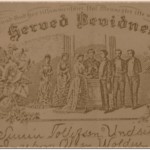 When tracing your Norwegian ancestors, you will learn that climbing your Norwegian Family Tree is a unique experience in genealogy research. From naming practices to language barriers and cultural differences, Norwegian genealogy is distinct in its resources and research techniques. In this article, Genealogy Beginner will pave your path with the basics of Norwegian genealogy research so you can start adding the names of your “Viking” forbearers to your family template.
When tracing your Norwegian ancestors, you will learn that climbing your Norwegian Family Tree is a unique experience in genealogy research. From naming practices to language barriers and cultural differences, Norwegian genealogy is distinct in its resources and research techniques. In this article, Genealogy Beginner will pave your path with the basics of Norwegian genealogy research so you can start adding the names of your “Viking” forbearers to your family template.
Ancestors From Norway: Getting Started
One of the first things you will need to understand about researching your ancestors from Norway is that the rules of following a single surname from generation to generation do not apply. Norwegian immigrants often took the name of the farm where they lived. This in itself can be a hint in your research. For example, in the case of two brothers, Johann Tollevson and Simon Tollevson who immigrated in the 1600’s one brother took the name Rugsveen and the other adopted the surname Undseth for the farms they were living on when they immigrated.
However once your research leaves the shores of North America your one name study ends. Prior to the 1900’s your Norwegian ancestors used a patronymic naming system where the child was given the first name of their father as a surname. In these cases, you will find, as in the case of the two brothers named above – Johann and Simon – that their fathers name was Tollev.
To get started digging for your Norwegian roots you will need your ancestors “Norwegian” name and date of birth along with the farm name where your ancestor lived. Although this may seem a little odd at first you will soon find that these peculiarities of Norwegian genealogy may be very helpful when searching out your ancestors from Norway.
Hints:
Norwegians were wonderful keepers of records and family bibles are very common
Norwegian dates are always written as…Day/Month/Year
Tools for Norwegian Genealogy
Once you have sorted out the names and dates of birth it is time to start gathering your research tools. Here is a short list to get you going.
– Family Tree Template
– Norwegian English Dictionary
– Word list for special terminology
Norway’s Genealogy Resources
Norway Church Registers
There are church registers for every parish in Norway with the oldest dating back to the mid 1600’s for some parishes. Records were recorded as both religious and and civil events for example a birth would be a civil event while a baptism is a religious event. Among the records of births, marriages and deaths you will often find entries of announcements made to the parish.
Norway Census
The earliest census in Norway took place in the 1600’s, these early census were called “Prestenes manntall” and recorded information for men, boys and sometimes widows. Sadly, Norway’s census records are incomplete and contain several errors, often with large parts of families missing. Beginning genealogists should know that Norwegian census is not considered a reliable source of information.
Bygdebok
Possibly the best resource for tracing your Norwegian ancestors is the Bydebok, a book of land records that contains a great deal of historic information. It often records a history of the families who owned the land… often into the 1300’s. Bygdebok are divided by communities listing the farms within one or two parishes and are a must have for anyone studying their Norwegian family history.
Other records available to genealogists are Probate, Mortgage and Tax Registers although like the census, the records are often incomplete.
The good news for anyone doing research on his or her ancestors from Norway is that there is a lot of information available on the internet. Join us on the Genealogy in General forum for a list of important links to get you started on your Norwegian genealogy.
Using DNA to Grow Your Family Tree: Guest Blog
April 5, 2012 by ramona
Filed under Articles, Getting Started in Genealogy, Introduction to Genealogy, Latest News
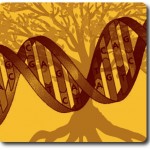 Genealogy Beginner Welcomes Guest Bloggers from the Sinclair DNA One name Study and the Salian DNA Project who have so wonderfully explained everything a genealogy beginner needs to know about how to use DNA testing to help with your genealogy research…and fill out your Family Tree Template!
Genealogy Beginner Welcomes Guest Bloggers from the Sinclair DNA One name Study and the Salian DNA Project who have so wonderfully explained everything a genealogy beginner needs to know about how to use DNA testing to help with your genealogy research…and fill out your Family Tree Template!
So what do you do when there are no more records to get you any further back in time on your family tree? Most of us get stuck at a brick wall which seems insurmountable and that’s where DNA comes in. By joining a DNA project and testing a male family member, you can compare that Y-DNA sample with others of the same surname.
Your Family Tree DNA: How It Works
Y-DNA is passed from father to son and contains a unique signature passed through the generations, which you share with the other project members. Another advantage is contact with others of the same surname to compare paper trails with and on top of that, you’ll find more relatives you didn’t have a clue existed, based all around the world.
In terms of cost, the least investment you can get away with is a 37 marker test and that would provide you with other matches of the same haplogroup as yourself. To be honest though, a 67 marker test though more costly, is far more revealing and those you matched at 37 markers will appear less closely related, whilst at 67 markers you can be fairly confident that those you match are descended from the same ancestor.
The closeness is measured in “genetic distance”; for example you could match exactly, or be one, two or more steps away in genetic distance from the other matches which will give a rough indication of how far back in time you relate to them.
DNA ONE-NAME STUDIES
There are plenty of one-name DNA studies on the internet but the majority of them use the www.FamilyTreeDNA.com laboratory for testing, mainly because they have the largest DNA database with 366,840 participants at the time of writing.
Some of these projects specialise in specific geographic areas and some in various ethnicities. For example, there are dedicated projects for those with Jewish, African or Native American ancestry as well as over 6,800 surname projects.
Not only can you compare your DNA with others of your own surname, you will be able to find matches across the whole of FamilyTreeDNA’s massive database as well which, strange as it may sound, can be extremely helpful in research terms.
Many adoptees have used DNA testing to find out who they really are by comparing their DNA results to the other surnames which show up in their matches, giving more clues to research their family history. You can join as many projects as you like or as many as are relevant to your family’s history and the other advantage of joining a project is a discounted price on the cost of your DNA test.
Just to be fair, there are other companies out there for example:
- Ancestry
- 23andme
- The Sorensen Molecular Genealogy Foundation
Who may be cheaper to test with than FamilyTreeDNA, but once those test results are in, there are considerably fewer other “testees” to compare your sample with and in the world of DNA testing for genealogical purposes, database size is everything!
DNA TESTS
Because DNA testing is still a relatively new science, using it to find relatives is the new frontier. Exciting developments are happening all the time and one of the latest such tools are “SNP’s” or “single-nucleotide polymorphisms”. These are small “mistakes” in the copying of DNA which occur just once and are then passed unchanged from generation to generation forever after.
Because they are much rarer, they are far more accurate in determining whether you relate closely to another potential match or not. The good news is that after the initial expense of a 37 or 67 marker test; testing individual “SNP’s” becomes more affordable when you want to take the plunge. That at least is a general outline of what happens.
Your Privacy
Privacy may be a worry for some, but your DNA sample is allotted a kit number and only that is shown on any project website along with the name of your earliest known ancestor and geographical location for him. (That is, provided you have signed a release form). If not, your DNA remains anonymous and no one will have access to it or your contact information. It’s your choice.
DNA is definitely a bit overwhelming at first; it’s true there is a lot to learn for the novice and it’s a constantly evolving science with new breakthroughs happening all the time, but that’s where your project leader should step in and explain what it means for you personally and for the project as a whole; advise whether it’s worth testing this or that.
DNA Communities
Most projects have forums on Yahoo and Google or even on Facebook which are very informative and specifically targeted to the project or projects you have joined. There is nothing to stop you joining as many projects and forums as may be relevant to your family history.
A word of caution though; no one has all the answers yet and you should not jump in expecting that your project leader will necessarily be an expert in the DNA field, although in general they have access to population geneticists or other DNA boffins who are more than willing to help answer queries.
DNA and Realistic Expectations
Mainly these projects are run by slightly more experienced enthusiasts with the same goals as yourself. Also, you may or may not find someone else with a paper trail you can connect to yours immediately, so don’t expect miracles.
It may even take years for the magic to happen where you find that elusive document which connects you on paper as well as with DNA. However, the DNA alone, matching others in your project means you are related to them at some point since the adoption of surnames began around the 12th or 13th century and you have a shared history and that’s a fairly exclusive club!

The Salian DNA Project: A New Direction in Genealogy
Genealogy + DNA + Archaeology = An Exciting New Direction for Family Tree Fanatics
Just to illustrate what DNA plus historical and archaeological research can achieve for genealogy:
Archaeology and Your Family Tree
Archaeology is playing an important part alongside the historical record and the Y-DNA. From the archaeological record in recent years, two ancient gravesites containing multiple burials:
- one dated to 670AD in Ergolding, Bavaria in southern Germany
- another dated to between 1000 and 700BC in Lichtenstein in central Germany
Thirteen of the skeletons excavated have been DNA tested and the results from four of them, (one at Lichtenstein and three at Ergolding), were found to have a distinctive marker, the S21 SNP.
The Ergolding results are the most interesting of the two, as there were high-value grave goods found alongside the skeletons, indicating that these burials were related to the Merovingian royal household, (according to the archaeologists, Dr Vanek et al), hence the connection with the Salian Franks; the ancestors of the Merovingian dynasty.
When Archaeology Meets DNA
The S21 SNP was discovered back in 2004 by Professor Ken Nordtvedt of Montana State University who announced that it represented those with Frisian ancestry; [Frisia was located in what is now the Netherlands, Germany and Denmark on the North Sea coast of Europe] and the date for this SNP was determined to be approximately 4,000 years ago. We now know from subsequent research that there are several clades [or branches] below S21, which are younger than that.
Several SNPs have been discovered over the past year, which have added to our knowledge and brought us further forward in time to about 1,900 years ago. There is a clade (or branch) of this S21 SNP which is Frisian/Anglo-Saxon in origin because that is where the highest concentration of matching samples in the local population are found today, however, S21 has other clades within it as well, which may represent a different branches, perhaps from associated tribes. The Salian Franks were settled in Toxandria, in close proximity to Frisia, just directly south of there, in fact and their homeland became part of what we today know of as The Netherlands and Belgium.
Our ancestors were far more mobile than we perhaps imagine and moving around within northern Europe 4,000 years ago, intermingling with other tribes in other nearby areas, but with no documentation that far back, we are struggling through the fog of distant time. In the years to come, that fog may be eradicated altogether.
The Genealogy Aspect
A large number of participants in the Salian DNA Project are named Sinclair with ancestral links to Caithness, Orkney and Shetland. Through the work of population geneticists such as Dr Jim Wilson at the University of Edinburgh, we know that our ancestors carrying the S21 SNP have left more evidence of their existence in eastern Scotland and eastern England. Indicating that our ancestors crossed the North Sea and invaded Britain at some point back in time and while through historical research we can document our common ancestor as Rollo, a Norwegian Viking, our family shows no sign of matching Norwegian DNA, so the old history books may well need to be rewritten.
Dr Wilson’s research in Orkney and Shetland has isolated those Sinclairs carrying the S21 SNP as being descendants of the Earldom Sinclair line. His extensive database shows the majority of Sinclairs in Orkney carry this SNP in their DNA and historically, there were no Sinclairs in the islands until shortly before Earl Henry Sinclair was installed as Earl in 1379. His family, based at Roslin, in Midlothian on the east coast of Scotland also fits with the evidence found of the S21 SNP in Scotland.
Salian DNA
The Salian DNA Project was designed to link all associated surnames, which have a common male ancestor and show the S21 SNP in their Y-DNA. A large proportion of them are Sinclairs, but anyone, as long as they have that all-important S21 SNP in their Y-DNA, can join, just make contact at: http://www.familytreedna.com/public/ulvungardynasty/default.aspx
Through the Salian DNA study, we are gradually narrowing down the geographical area of our origins and we have learnt a lot over the years. By sharing research as well as our DNA results it has also become gradually clear that many people who adopted the Sinclair surname back in the past, were not actually related to one another.
Surnames began to be adopted very slowly after the Norman Conquest of Britain in 1066 and another complication is the problem of “non-paternity events” or illegitimate male children given their mother’s surname, adoption, or alternatively born as the result of an affair and raised as a Sinclair or St Clair.
DNA has a way of winkling out those who adopted the name for whatever reason and drilling down to find the genuine descendants of a known ancestor with a documented history in the geographical areas where a family was known to have been in the more recent past.
It’s an absorbing and contagious hobby, so come and join us when you’ve taken that all important DNA test!
To learn more about this exciting study please join us on the Discovery Panel Forum for some fantastic links.
Fill out Your Family Template the Easy Way
March 29, 2012 by ramona
Filed under Articles, Getting Started in Genealogy, Introduction to Genealogy, Latest News
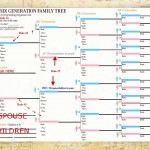 Have you ever felt confused about how to fill out a Family Tree Template?
Have you ever felt confused about how to fill out a Family Tree Template?
- Wondered what the numbers mean?
- Who you should include?
- Where to start?
Here are a few simple rules to follow that will have you filling out your Family Template in no time.
Family Template Rule #1 = YOU
Always start with yourself. Your name goes in the number one spot on the chart along with your vital statistics information such as when and where you were born. A space for the place and date of your marriage should be below that and if you look down many Family Tree Templates include an area to record the name of your spouse and children.
Family Template Rule #2 = MEN
Slightly indented and up from spot number one you should find the numbers two. This is where you will record your fathers name and information.
The rule if thumb:
- The males in your family will always have even numbers (2,4,6,8)
- The males in your family will always follow the upper track on a family template.
Family Template Rule #3 = WOMEN
Slightly indented and below number one you will find the number three spot
The Rule of thumb:
- The maternal lines of your family will always have odd numbers (3,5,7,9)
- The maternal lines of your family will always follow the bottom track on a Family Tree Template
Family Template Rule #4 = Generations
If you follow these rules through every generation, you will never be confused again. However, wait we are not quite finished yet. If you look on the upper left hand corner of your Family Template, you will notice a little box that says, “Chart#”. This area is needed for when you family tree goes beyond the number of generations on the chart.
Rule of Thumb:
- The template that includes you and your immediate family is always number one
- Number your Family Tree Templates consecutively to avoid confusion. For example if you were starting on a seventh generation, you would need to begin another Family Template and that template would be number two.
Note: Just below the “Chart #” box, there is a space that says “Note: “1” on this chart is the same as ____ on chart ____. This section is to help keep you organized when working with multiple Family Tree forms. For example if you were making a desendance report, this gives you a quick reference to where you can be found in the report.
Family Template Rule #5 = Documentation
All good genealogy research endeavors to document findings with copies or originals of birth, marriage and death records.
Rule of Thumb:
- Use a pencil to fill out the names for individuals for which you do not have documentation
- Use a pen to fill out the names for individuals for which you do have documentation
Family Template Rule #6 = Extended Family
Your Family Template is for your direct line of ancestry
Rule of Thumb:
- Uncles, aunts and cousins are not included on your Family Tree Template.
Here is a visual cue to help you get started (Click for a larger view)
Now that you are ready to begin filling in your family’s generations all you need is a Family Tree Template, just follow this link and download your FREE FAMILY TEMPLATE today.
Family Tree Confusion
December 9, 2008 by Chris
Filed under Articles, Blank Family Tree, Genealogy Reports and Charts, Introduction to Genealogy
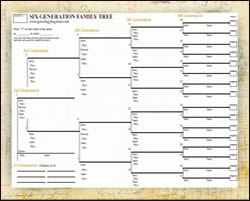
A little while ago we talked about the fact that there are a lot of family tree templates available online. Many of them are extremely fancy and can be very confusing. These decorative templates are great for presentation purposes; however, most people are looking for a simple solution and don’t want to spend endless hours trying to understand this box or that branch. I thought I would take this opportunity to describe my approach here at Genealogy Beginner.
Continue reading “Family Tree Confusion” »
How To Make Family Tree
November 16, 2008 by Chris
Filed under Blank Family Tree
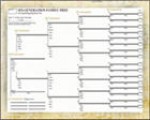 There can be a lot of confusion the fist time you’re trying to figure out how to make a family tree. There are so many sites, resources, templates, and so-called experts that you’re left wondering which way is up. This short article is designed to provide you with a few simple steps that will allow you to get started so you know exactly how to make a family tree. First you need a blank family tree template. You can get one for free at the www.genealogybeginner.com website. Once you download your blank family tree template you’ll need to complete it for yourself and your parents.
There can be a lot of confusion the fist time you’re trying to figure out how to make a family tree. There are so many sites, resources, templates, and so-called experts that you’re left wondering which way is up. This short article is designed to provide you with a few simple steps that will allow you to get started so you know exactly how to make a family tree. First you need a blank family tree template. You can get one for free at the www.genealogybeginner.com website. Once you download your blank family tree template you’ll need to complete it for yourself and your parents.
Just start here. It can be as simple as digging out your own birth certificate and (if appropriate) your marriage certificate, writing do the dates on the blank family tree template, and filing away our certificate copies.
Next you do the same for your parents. You’ll likely need to speak with them about their own parents and to ask for original copies of their birth and marriage certificate so you can make copies and add them to your records.
And that is really what building a family tree is all about. The trick to how to make a family tree is not all that hard (but can be frustrating if you don’t have the basics). It’s a process of identifying the three primary certificates for each of your ancestors (Birth Certificate, Marriage Certificate, and Death Certificate), obtaining copies, and then making notes about who leads to who on a family tree.
Now your family tree search doesn’t need to be limited to just this. While these are the core tasks there is a wealth of other items you can work on and develop to make your tree even richer.
For example, you’ll want to collect any family artifacts you come across like:
- Photos
- Deeds
- Court filings
- Estate records
As well as anything “official” that marks the existence of your family. Some folks make a point to take photos of grave stones or even do gravestone etchings to add to their tree.
With all of these materials in place, you have the basis for a great scrapbook or similar type family heirloom that can be passed down for generations to come. Get an artistic rendering of your official family coat of arms (if you have one), put it on the cover, and you have a wonderful book that defines your legacy.
You see, learning how to make a family tree doesn’t need to be complicated or overly confusing. It simply takes a little understanding of the basics and the will to figure it all out. Check out the resources below if you need a little more assistance:
- Download a Blank Family Tree Template
- Download instructions on How to Complete a Family Tree
- Download a Step-by-Step Genealogy Guide to get you started with your online research.
Genealogy Search
November 13, 2008 by Chris
Filed under Genealogy Reports and Charts, Getting Started, Introduction to Genealogy
 There are a large number of free websites that exist simply for your use in a family history search. These sites contain databases and search capabilities that can quickly aid in determining whether you are on the right path in your search. We suggest you start with a solid Blank Family Tree Template. If you don’t know about it already, it is time to become familiar with the Latter Day Saints’ extensive Web site, which covers parts of Europe, the East Coast and North America for several generations. The Latter Day Saints are renowned for their work in genealogy.
There are a large number of free websites that exist simply for your use in a family history search. These sites contain databases and search capabilities that can quickly aid in determining whether you are on the right path in your search. We suggest you start with a solid Blank Family Tree Template. If you don’t know about it already, it is time to become familiar with the Latter Day Saints’ extensive Web site, which covers parts of Europe, the East Coast and North America for several generations. The Latter Day Saints are renowned for their work in genealogy.
Although records have been found dating back to a person in Europe in 1200 A.D., the Latter Day Saints’ Web site information is not as complete as the CD databases available at public genealogy libraries or at their own genealogy libraries located in most major cities around the world.
Note: In The Step-by-Step Genealogy Guide, we discuss searching public records in detail, including how to get free, professional, one-on-one assistance. The Guide also offers more information abut the LDS website plus provides extensive details about getting the most of an actual visit to the library.
Set a specific goal for each online family history search session (i.e., the one hour you have on Sunday before junior wakes up from his nap) Try to narrow your search and only look at those items that are closely related to your quest. It is possible to spend many fascinating, yet useless hours chasing information. Try to remain focused on your search.
Now Download the full Genealogy Guide and keep your research going!

